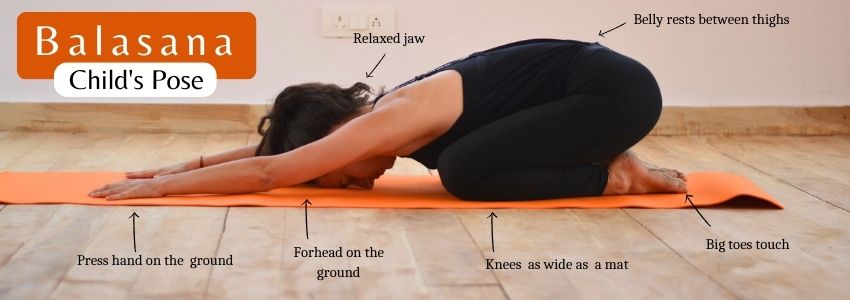
Balasana - Child's PoseBalasana, commonly known as Child’s Pose, is a simple yet powerful yoga asana often practised in various yoga routines and styles. This pose resembles the fetal position, providing comfort and security.
Yoga Teacher Training Course can be physically demanding, with participants engaging in long hours of yoga practice, meditation, and study. Balasana (Child’s Pose) is a commonly practised yoga asana in various 200 Hour Yoga Teacher Training in Rishikesh, often used as a resting pose or a transition pose between more strenuous asanas. It allows students to take a break, recover their breath, and restore their energy, making it an essential part of the TTC curriculum.
Benefits of Balasana (Child’s Pose):
- Relieves Stress and Anxiety: Balasana is renowned for calming the mind. It allows you to focus inward, facilitating relaxation and stress relief. The gentle pressure on the forehead can be particularly soothing.
- Stretches the Spine: When performed correctly, Balasana elongates the spine, helping to improve posture and relieve tension in the back. It’s an excellent pose for individuals sitting at a desk for long hours.
- Aids Digestion: The gentle compression of the abdomen in a Child’s Pose massages the internal organs, promoting healthy digestion and alleviating digestive discomfort.
- Relieves Neck and Back Pain: This pose gently stretches the neck and lower back muscles, making it practical for individuals with neck or lower back pain. It can also be therapeutic for those with sciatica.
- Enhances Flexibility: Regular practice of Balasana can improve the flexibility of the hips, thighs, and ankles. It is especially beneficial for individuals working on hip-opening poses.
Quiets the Mind: Balasana is often a resting pose during yoga classes. This moment of stillness and introspection helps to clear the mind, making it a valuable tool for meditation and mindfulness practice.
How to Do Balasana (Child’s Pose):
Here is a step-by-step guide on how to perform Balasana:
1. Starting position: Begin by kneeling on the floor with your big toes touching and knees apart, slightly wider than hip-width apart.
2. Sitting Back: Sit back on your heels, ensuring your toes are touching and your buttocks are resting on your heels.
3. Forward Bend: Exhale as you bend forward at the hips, bringing your torso between your thighs.
4. Arm Placement: Extend your arms forward on the mat, palms facing down, and place them shoulder-width apart.
5. Forehead to the Mat: Gently rest your forehead on the mat. If your forehead doesn’t reach the ground, you can place a cushion or block underneath for support.
6. Relaxation: Close your eyes and relax in this position. Breathe deeply and evenly, feeling the stretch in your spine and the release of tension in your back and neck.
7. Duration: Stay in Balasana for as long as possible, typically 1-5 minutes or longer if desired.
8. Release: To exit the pose, slowly walk your hands back towards your body, lifting your torso and returning to kneeling.
9. Resting Pose: After Balasana, you can sit in a comfortable cross-legged position for a few breaths to transition before continuing with your practice or daily activities.
Conclusion:
Incorporate Balasana into your daily yoga routine to experience its myriad benefits. Whether you practice yoga for physical fitness, stress relief, or emotional balance, Child’s Pose can be a valuable addition to your repertoire. Listen to your body and modify the pose to suit your flexibility and comfort level.